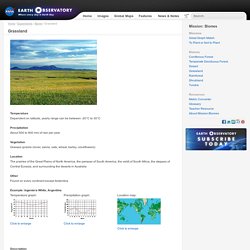

KDE Santa Barbara. Location | Weather | Plants | Animals | People | Links LOCATION: The name for this biome, temperate grasslands, is a great description for what it is like here.

The most important plants in this biome are grasses! Temperate grasslands have some of the darkest, richest soils in the world (not in wealth, but in nutrients). People who live in grassland regions often use these soils for farming. WEATHER: Temperatures in this biome vary greatly between summer and winter. PLANTS: Grasses dominate temperate grasslands. ANIMALS: All grasslands share a lack of shelter from predators, and an abundance of grass for food; therefore, grassland animal populations are similar throughout the world.
PEOPLE AND THE TEMPERATE GRASSLAND: One of the main environmental concerns regarding temperate grasslands is the conversion of grassland to farmland. The Grassland Biome Geography for Kids: Grassland Biomes Grassland Explorer Blue Planet Biomes: Grasslands Prairies in the Prairie State Back to Biomes Index. Grassland Plants. List of Grassland Animals. Grassland : Mission: Biomes. Temperature Dependent on latitude, yearly range can be between -20°C to 30°C Precipitation About 500 to 900 mm of rain per year Vegetation Grasses (prairie clover, salvia, oats, wheat, barley, coneflowers) Location The prairies of the Great Plains of North America, the pampas of South America, the veldt of South Africa, the steppes of Central Eurasia, and surrounding the deserts in Australia Other Found on every continent except Antarctica Example: Ingeniera White, Argentina Description Grasslands are generally open and continuous, fairly flat areas of grass.

The height of grass correlates with the amount of rainfall it receives. The grasses die back to their roots annually and the soil and the sod protect the roots and the new buds from the cold of winter or dry conditions. The grassland biome. Online exhibits : The world's biomes The grassland biome Grasslands are characterized as lands dominated by grasses rather than large shrubs or trees.

In the Miocene and Pliocene Epochs, which spanned a period of about 25 million years, mountains rose in western North America and created a continental climate favorable to grasslands. Ancient forests declined and grasslands became widespread. Following the Pleistocene Ice Ages, grasslands expanded in range as hotter and drier climates prevailed worldwide. Savanna Savanna is grassland with scattered individual trees. The soil of the savanna is porous, with rapid drainage of water. Savanna has both a dry and a rainy season. Other animals (which do not all occur in the same savanna) include giraffes, zebras, buffaloes, kangaroos, mice, moles, gophers, ground squirrels, snakes, worms, termites, beetles, lions, leopards, hyenas, and elephants.
Grasslands Biome. Grassland biomes are large, rolling terrains of grasses, flowers and herbs.

Latitude, soil and local climates for the most part determine what kinds of plants grow in a particular grassland. A grassland is a region where the average annual precipitation is great enough to support grasses, and in some areas a few trees. The precipitation is so eratic that drought and fire prevent large forests from growing. Grasses can survive fires because they grow from the bottom instead of the top. Their stems can grow again after being burned off.
When the settlers of the United States moved westward, they found that the grasslands, or prairies as they called them, were more than just dry, flat areas. There are two different types of grasslands; tall-grass, which are humid and very wet, and short-grass, which are dry, with hotter summers and colder winters than the tall-grass prairie. National Geographic. Grasslands go by many names.

In the U.S. Midwest, they're known as prairies. In South America, they're called pampas. Central Eurasian grasslands are referred to as steppes, while in Africa they're named savannas. What they all have in common is grass as their naturally dominant vegetation. In fact, most grasslands are located between forests and deserts. There are two different kinds of grasslands: tropical and temperate.
Tropical grasslands are warm year round, but usually have a dry and a rainy season. Temperate grasslands, which average between 10 and 30 inches (25 and 75 centimeters) of rain per year, have shorter grasses, sometimes just a few millimeters.